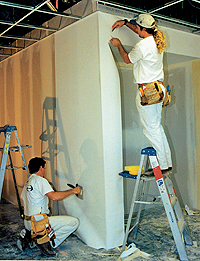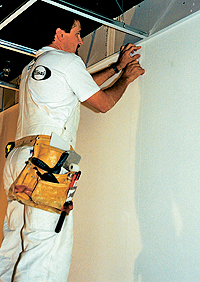
Wallpaper Adhesives,
Wallpaper Seams
Walls should receive a coat of pigmented acrylic wallcovering primer — not a paint primer — to protect the surface, promote adhesion, prevent mold and mildew, and make it possible to easily strip off the wallpaper when it comes time to redecorate.
by Christina M. Camara
is a daily challenge for all professional paperhangers, but experts say good knowledge of your products, sparing use of the right adhesive and proper technique will result in tight seams and satisfied customers.
Achieving that look starts long before the first sheet is hung. Jim Turner, president of Regency Wallcraft of Columbus, Ohio, says the wall surface must be sound, dry and smooth. If the wall isn’t sound, you’ll have installation failures. If it’s not dry, the wallcovering won’t adhere, seams won’t lay down, and mold and mildew can grow. If it’s not smooth, the wallcovering won’t disguise the flaws. In fact, surface irregularities will show through the paper, especially if specialty lighting is used. Walls should receive a coat of pigmented acrylic wallcovering primer — not a paint primer — to protect the surface, promote adhesion, prevent mold and mildew, and make it possible to easily strip off the wallpaper when it comes time to redecorate.
 Once you've started a double cut with your knife, using a hook knife for the rest of the cut helps to prevent any possible scoring of the sheetrock. Once you've started a double cut with your knife, using a hook knife for the rest of the cut helps to prevent any possible scoring of the sheetrock. |
Becky Duvall, owner of Wallpaper Hanging by Becky in Broken Arrow, Okla., says using the correct wallcovering primer is key. She uses different primers depending on the kind of surface she is working with, whether it’s new Sheetrock, plaster or painted walls. And despite what home decorating shows on cable television say, never hang wallpaper directly onto a painted wall — eventually the adhesive will eat through the paint and lift the seams. “Proper wall preparation is the whole solution to a good installation,” she says. Glen Olsen Jr., CP, a third generation paperhanger who owns V&G Services of Woodridge Ill., says blankstock is one of the most under-used products in the industry today. Even though hanging the liner will increase the installation cost, it creates a smooth, strong foundation for the wallpaper. The fibrous blankstock absorbs excess moisture from the paper and allows it to dry quickly with less or no chance of shrinking. Olsen hangs the blankstock horizontally, which forms a lattice arrangement that can counteract any torque on the wall surface, keeping the seams tight, even over walls with many previous paint layers.
Installers say it’s also important to match the right adhesive to your wallcovering materials, and to use the adhesive correctly.
“The key is, less adhesive is always better,” Turner says. “It takes hardly any adhesive to lay wallcoverings down, generally speaking.” Too much adhesive will almost always lead to excessive shrinkage because the wallpaper will slide across the wet surface faster than the adhesive is drying. A clear, strippable adhesive is the most popular “one-bucket choice,” he says. He carries five different adhesives in his truck, including wheat paste, cellulose, clay, clear and vinyl-over-vinyl adhesives.  Duvall likes to use Zinsser’s Sure-Grip activator and Roman’s Techna-Grip for prepasted wallpapers, and Roman’s Heavy Duty Clear Pro-838 on her high-end, unpasted papers. She also uses Roman’s Ultra Pro-880, which is dryer than their Heavy Duty Clear. If she’s hanging an untrimmed paper or one with heavy inks, the Pro-880 will grab the seam better. Duvall likes to use Zinsser’s Sure-Grip activator and Roman’s Techna-Grip for prepasted wallpapers, and Roman’s Heavy Duty Clear Pro-838 on her high-end, unpasted papers. She also uses Roman’s Ultra Pro-880, which is dryer than their Heavy Duty Clear. If she’s hanging an untrimmed paper or one with heavy inks, the Pro-880 will grab the seam better. Which adhesive to use depends on what kind of paper you’re working with, how heavy the inks are and what kind of substrate is used, she says. Using the wrong adhesive can result in stains if the adhesive bleeds through. Olsen likes the results of Roman’s Pro-595 Kitchen and Bath Wallpaper Adhesive, which stands up very well in hot, steamy environments, preventing seams from opening up. “It just doesn’t go away,” he says. “Water doesn’t attack it as fast.” However its gluey consistency makes it difficult to clean up, he says. Gary Thomas, owner of Star Wallcovering in Granite Bay, Calif., swears by Gibson-Homans Dynamite 111, using it in different dilutions for various projects. He says his company used the product on 12 floors of a 14-floor project. Seams were visible on only two floors — the ones where he didn’t use the Dynamite 111. “When I put a seam together with 111 it never fails,” he says. He noted, through, that it’s a non-strippable adhesive, so he uses clay strippable adhesives on schools or other projects where a strippable wallcovering is required.
|

